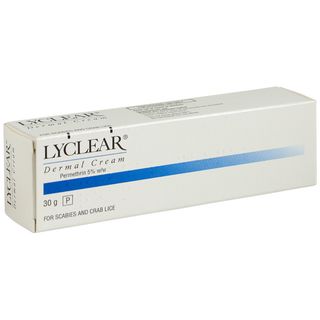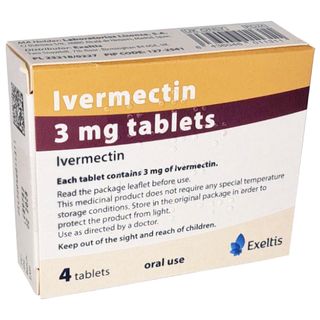
Scabies
‘Scabies’ is one of those words that can make you feel itchy the moment you hear it. Caused by tiny, burrowing mites, scabies can make your skin intensely irritated. Unfortunately, the condition is highly contagious and if one person in your family or household has it, everyone will need to get treated. The good news is that treatment is quick and effective. You’ll need to apply specialist cream to your whole body to ensure no mites are left behind, after that, you should be in the clear. At The Independent Pharmacy, we're here to provide the support and treatments you need to manage scabies effectively. Let us help you restore comfort and health to your skin.
Scabies Treatments
- Best seller
 Permethrin 5% Cream - Effective Scabies and Crab Lice Treatment£10.69
Permethrin 5% Cream - Effective Scabies and Crab Lice Treatment£10.69 
Lyclear 5% Cream - Scabies & Crab Lice Treatment
Lyclear 5% Cream - Scabies & Crab Lice Treatment£11.99- Best seller

Ivermectin Tablets
Ivermectin 3mg Tablets£166.50
Start your assessment for Scabies
Don't wait to get the medical help you need.
Once you complete a short online assessment about your condition, you will be able to select your preferred treatment and quantity from a list of appropriate options for you.
- Reviewed by our UK-based medical team
- Takes less than 3 minutes to complete
- Approved treatments dispatched same day (before 3pm)
Ordering as easy as 1, 2, 3
1. Find the ideal treatment
2. Get a free consultation
3. Enjoy speedy delivery
Advice for Scabies
What is Scabies?
Scabies is a contagious skin condition caused by tiny mites called Sarcoptes Scabiei. Using their mouth and front legs, these mites burrow into the skin’s outer layer (epidermis), where they lay their eggs. These eggs hatch within three to four days producing larvae mites, which return to the skin’s surface to mature and repeat the life cycle. This cycle can continue indefinitely unless the correct treatment is sought. Scabies mites are incapable of jumping or flying, the only way they are spread is through direct, prolonged physical contact with an infected person or object. For example:
- Having sex with someone infected with scabies
- Holding hands with an infected individual for prolonged periods of time
- Sharing clothes, towels or bedding with an infected person
If infected by the scabies mite you will experience severe itching and a skin rash on the areas where the mites have burrowed. The itching tends to worsen at night, potentially hindering sleep. The scabies mites thrive in warm conditions, which is why they will often inhabit the warmer areas of the body, such as skin folds, between fingers or toes, around the buttocks and breast creases. In the UK scabies tends to be more common during the winter months. This is attributed to people spending larger amounts of time indoors, hence being in closer quarters with others for longer. It’s difficult to gauge exactly how many cases of scabies affect the UK each year as most people don’t visit their GP, opting instead to self-treat using over-the-counter medicines.
What are the symptoms of Scabies?
After the initial infection, someone suffering from scabies may take up to eight weeks to present with any symptoms. This is due to the incubation period. After this period the sufferer will start to experience an intense itching accompanied by a red rash. This rash will be the result of the scabies mites burrowing through the outer layer of the skin. The scabies rash will resemble tiny red spots. It is not recommended to scratch the rash as it may result in developing crusty sores. Burrow marks are also a visible symptom. They are small in size and will resemble a wavy, silver-coloured line with a tiny black dot at one end.
For adults infected with scabies, it is common for burrow marks to appear in the following areas:
- Between the fingers and toes
- In and around skin folds
- For men; around the genitals
- For women; around the nipple area
- The sides and soles of the feet
- The elbows & wrists
The scabies rash can affect anywhere on the body with the exception of the head. The most common areas for the rash to appear include:
- The lower buttocks
- The groin
- Female genital area
- Underarms
- The inside of the elbow
- Around the waist
- The knees, lower legs and around the ankles
- The shoulder blades
Infants, young children and the elderly may present with burrow marks in places not usually associated with an infection in a healthy adult. These places include:
- The neck, face and scalp
- The palms of the hands & the soles of the feet
How is Scabies diagnosed?
Self-diagnosis of scabies is usually possible through a simple visual inspection of the skin. If necessary, your GP will look for the burrow marks produced by the Sarcoptes scabiei mite. By examining and identifying the scabies rash and burrow marks, the doctor will be able to rule out other skin conditions that may be causing the itchy rash, such as impetigo or eczema.
If you are concerned you may be suffering with genital scabies, or if your partner has already been diagnosed with it, then it will be necessary to visit your nearest sexual health clinic. Here you can be properly examined and provided with the appropriate treatment.
What treatments are available for Scabies?
If it has been confirmed that you have scabies, it will be necessary to treat you and your partner as well. This is regardless to whether they are presenting with symptoms or not, as it is highly likely that the infection will have been transmitted through close bodily contact.
Lotions and creams to treat scabies are commonly available over the counter without needing a prescription. One such treatment is Lyclear Dermal Cream. Lyclear Dermal Cream contains Permethrin, which belongs to a group of medicines called pyrethroids. This group of medicines kills the scabies mites.
Lyclear cream is applied all over the body to clean, dry skin, paying particular attention to the difficult-to-reach areas - one 30g tube should be sufficient to treat an adult. If necessary a cotton bud can be used to apply the treatment under the finger and toenails. The cream will then need to be left on for at least eight hours and washed off with soap and water within 12 hours. Usually, one application is sufficient, however, this process can be repeated in one week if necessary. Scabies treatment, such as Lyclear Dermal Cream, is usually recommended for all members of the same household. Treating other household members should take place at the same time as the treatment for the infected person.
Anti-itch cream, such as Eurax - containing crotamiton, helps to soothe the itching and relieve discomfort associated with scabies. It does not treat the infection.
How can I avoid catching Scabies?
Scabies is best prevented by avoiding direct skin-to-skin contact with an infected person. Also, by avoiding contact with contaminated items that belong to the infected person, such as clothing, bedding and furniture. The scabies mites aren’t able to survive more than two or three days away from human skin, so any clothing or bed linens worn or used by someone infected three days prior to treatment should be washed using hot water and dried at the hottest dryer cycle. Infected objects that cannot be washed, such as furniture, should be avoided or enclosed in a plastic bag for several days.
It’s important to acknowledge that even when following these strict preventative measures it is still possible to contract scabies. The problem being, a person infected for the first time can take up to two months to develop any symptoms. During this time they are still able to unknowingly spread the infection to others. So preventing scabies is possible but even the best preventative measures can fail under certain circumstances.
FAQs for Scabies
What is Scabies?
Scabies is an infestation of a human skin mite known as Sarcoptes scabiei. They are microscopic mites that can burrow into the top layer of skin. A normal scabies infestation only involves 10 – 15 mites. Scabies is found all around the world and can infect anyone.
How long will symptoms of Scabies take to show?
In people who have never had scabies before, symptoms of an infestation can take up to 4 – 6 weeks to present. If you have had scabies before, symptoms may show after just 1 – 4 days. It is important to remember that during the incubation period, even though you do not have any symptoms, you are still infectious and can pass scabies on to others.
What causes the itching associated with Scabies?
The itching associated with scabies is caused by the toxins released by the scabies mites, not the mites themselves. Therefore the itching can continue for over a week after the mites are dead.
I have applied Scabies treatment and I am still itchy, should I re-apply?
Scabies treatment is normally one-off but it can take a number of weeks for the itching to subside. Even after the mites are dead, itching can persist for a number of weeks due to the leftover toxins in your skin. During this time you can use an anti-itching cream like Eurax to soothe the area. If the itching lasts for more than 2 – 4 weeks re-treatment may be necessary.
Do I need to treat my family as well?
Whether you treat your family for scabies as well as yourself will depend on a number of factors, however in most cases it is wise to treat the whole household for scabies at the same time to prevent reinfection.
Can I catch Scabies from my pets?
No, scabies mites solely infect humans. There is an animal equivalent known as ‘mange’. It is possible for a ‘mange’ mite to burrow into human skin on contact with an infected animal, however they cannot reproduce in humans and will die after a few days.
How can I remove any Scabies mites from my clothes?
To remove scabies mites from clothes, bedding and towels they should be put in a hot wash. This will kill the scabies mites. Scabies mites naturally die after 2 – 3 days of not being on human skin.
How contagious is Scabies?
Scabies can be caught from someone following prolonged physical contact. Simply shaking hands or brushing against someone presents a low risk of catching scabies. However, having sex with someone with scabies poses a high risk of transmission and it is likely that person will require treatment.